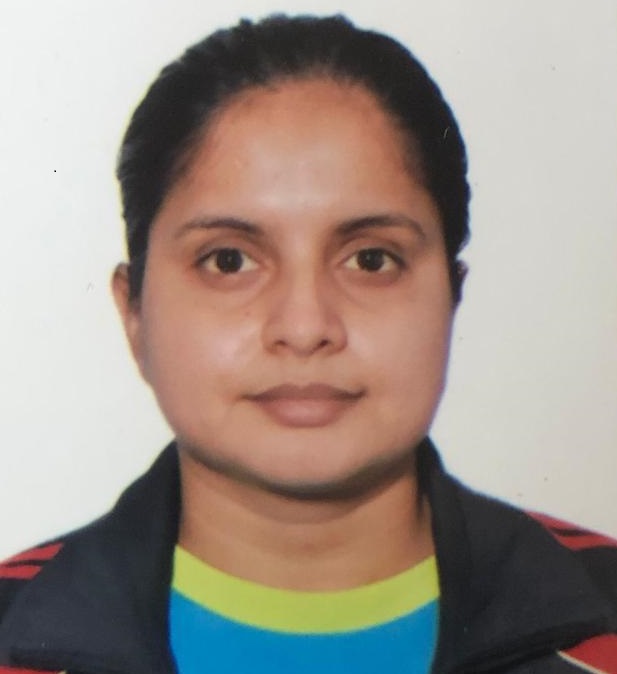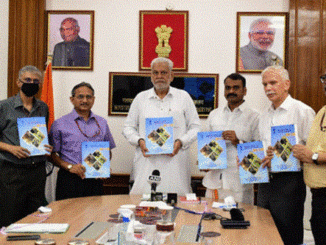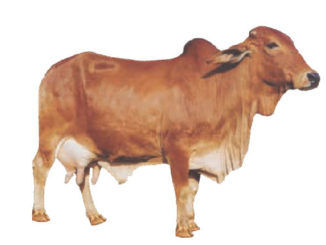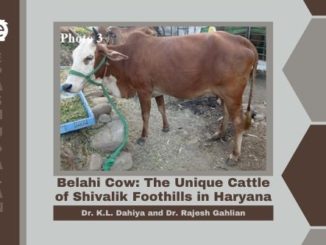Introduction
In India, raising cattle has long been a traditional source of income and is strongly associated with the agricultural sector. According to the 20th Livestock Census 2019, India has 192.41 million cattle, among which 142.11 million i.e. 73.83%, are indigenous. There are 53 recognized indigenous breeds that comprise India’s cow genetic pool. Native cattle from India are resilient and well-suited to the environment in each of their several breeding tracts. They possess traits including disease resistance, heat tolerance, and the capacity to flourish in harsh climates with limited nutrition. This article discusses some of the key traits of the indigenous cow breeds found in central India.
- Dangi/ Kandadi : Gujarat and Maharashtra
Dangi cattle have distinct white coat colour with red or black spots distributed unevenly over the body. Horns are short (12-15 cm) and thick with lateral pointing tips. Animals with inward and also with downward pointing horn tips are also available in sizable numbers. Uneven distribution of black or red spots over the body. Forehead is slightly protruding. They are well known for their hardiness and excellent working qualities in heavy rainfall areas, rice fields and hilly tract
- Deoni : Maharashtra and Karnataka
Deoni cattle also known as Surti, Dongarpati, Dongri, Wannera, Waghyd, Balankya and Shevera. Body colour is usually spotted black and white. This breed has three strains viz.1. Complete white (Balankya) 2. Complete white with partial black face (Wannera) 3. Black and white spotted (Waghyd or Shevera). Horn emerge from the side of the poll behind and above the eyes in outward and upward direction. Horn size is small and the tips are blunt. Black and white spotted body colour, drooping ears, prominent and slightly bulging forehead.
- Gaolao: Madhya Pradesh, Chhattisgarh and Maharashtra
Gaolao also known asArvi, Gaulgani. Body colour is blackish white in males and white in female. Males are generally grey over the neck. Horns are short and stumpy and curve slightly backward. Head markedly long and narrow tapering towards muzzle. Forehead receds at the top giving a slightly convex appearance. Eyes almond shaped and placed slightly at angles.
- Gangatiri: Uttar Pradesh and Bihar
Gangatiri also known asEastern Hariana or Shahabadi. The colour of cattle is Complete white (Dhawar), Grey (Sokan) with Medium sized horn that emerges from side of the poll behind and above eyes in outward and curving upwards and inwards ending with pointed tips. Its Forehead is Prominent, straight and broad with shallow groove in the middle. Eyelids, muzzle, hooves and tail switch are generally black
- Gir: Gujarat
Gir also known as Bhodali, Desan, Gujarati, Kathiawari, Sorthi, and Surati. Most of the Gir animals are pure red though some are speckled red. Horns are peculiarly curved. Starting at the base of the crown they take a sideways downward and backward curve and again incline a little upward and forward taking a spiral inward sweep, ending in a fine taper- thus giving a half moon appearance. Long and pendulous ears folded like a leaf and hang all the time and their inside face is forward. Gir is a world-renowned breed known for its tolerance to stress conditions. Having faced scarcity for a numbers of years, it has the capacity for yielding more milk with less feeding and is resistant to various tropical diseases. It has been imported by Brazil, USA, Venezuela and Mexico, and bred there successfully.
- Hariana/ Hansi: Uttar Pradesh and Haryana
Animals are white or light grey in colour. In bulls colour in between fore and hind quarters is relatively dark or dark grey. Horns are small in size. Visible characteristics are White colour, long and narrow face, well-marked bony prominence at the Centre of poll and small horns.
- Kankrej: Gujarat and Rajasthan
Kankrej also known as Wadad or Waged, Vagadia, Talabda, Nagar, Bonnai. Colour Varies from silver-grey to iron grey or steel grey. In males fore & hind quarters and hump are slightly darker than the rest of the body. Horn are strong and curved outward and upward in a lyre shaped fashion. They are curved with skin to a longer distance as compared to other breeds. It is the Heaviest breed of cattle with Strong lyre shaped horns, large pendulous and open ears. The gait of the Kankrej is peculiar to the breed; the action is smooth, there is hardly any movement of the body, the head is held noticeably high, the stride is long and even and the hind hoof is placed well ahead of the impression of fore hoof. This gait is called 1¼ paces (Swaichal) by the breeders.
- Kenkatha/ Kenwaria: Madhya Pradesh and Uttar Pradesh
Synonym of cattle is Wadad or Waged, Vagadia, Talabda, Nagar, Bonnai. Its colourvaries from grey on the barrel to dark grey on the rest of body.its horn Emerges from the outer angles of the poll in markedly forward direction and terminate in sharp points. It is Small, sturdy and fairly powerful animal. Horns directed forwards. They thrive on poor feed and fodder resources.
- Kherigarh: Uttar Pradesh
Kherigarh also known as Kheri, Kharigarh, Kharihave white coat colour. Some animals have grey colour distributed all over body especially on face. Horns are upstanding, curving outward and upward. These are thick at the base. Horn formation is typical of lyre-horned Malvi type. Horns are medium in size (15 cm). They are small but active animal. Animals are resistant to diseases and the expenditure on treatment is almost nil.
- Malvi: Madhya Pradesh
Malvi also known as Mahadeo-puri, Manthani are white or white greyish-darker in males, with neck, shoulders, hump and quarters almost black. Cows and bullocks become nearly pure white with age. Horns are curved, emerge from the outer angle of the poll in an outward and upward direction and 20-25 cm in length. They are Strong well-built whitish grey animal with lyre shaped horns.
- Mewati: Rajasthan, Uttar Pradesh and Haryana
Mewati also known as Kosi and Mehwatiare usually white with neck, shoulders and quarters of a darker shade. Horns are outwards, upwards and inwards in majority of animals; and outwards and upward in some animals. Tips pointed. Small to medium in size. Their Face is long and narrow with straight, sometimes slightly bulging forehead.
- Nagori: Rajasthan
Cattle are generally White or light Grey. In some cases head, face and shoulder are slightly greyish. Horns emerge from the outer angles of poll. They extend in an outward direction and are carried upward with gentle curve to turn in at points. Horns are medium in size. They are white, upstanding, very alert and agile animal with long and narrow face like that of a horse. Bullocks are big and powerful. They are capable of heavy draught work in deep sand. There is a tendency to legginess and lightness of bone, though feet are strong. This characteristic has given the breed its agility and case of movement. It turn like a horse.
- Nimari: Madhya Pradesh
Nimari also known as Khargaon, Khargoni, Khurgoni are Brownish red (Copper colour) and white giving spotted appearance (Chitkabri). Horns usually emerge in a backward direction from the outer angles of the poll, somewhat in the same manner as in Gir cattle, turning upward, outward and finally inward. They are Massive body structure, typical red colour with large splashes of white and bulging forehead.
- Ponwar: Uttar Pradesh
Ponwar cattle are usually Brown or Black with white patches. There is no particular pattern but black and white patches are intermixed. Horns emerge outward, upward and then curve inward with pointed tips. Sometimes horns curve backward in the end. Horns are medium in size. Because of the predators animals have a nervous nature and move in groups putting their heads in between each other. It is very difficult, rather impossible to take out one animal from the group. Animals behave just like semi-wild type and are very difficult to handle
- Rathi: Rajasthan
The animals are usually Brown with white patches all over the body, but animals having completely brown, or black coat with white patches are often encountered. The lower body parts are generally lighter in colour as compared to the rest of body.Horns are curving outward, upward and inward. Horns are short to medium in size.Face is broad between eyes and slightly dished. Dewlap is fine and loose. Tail- long, fine tapering to a good black or white switch well below the hock.
- Sahiwal: Rajasthan and Punjab
Sahiwal also known as Lambi Bar, Lola, Montgomery, Multani and Teli are Brownish red colour, shades may vary from a mahogany red brown to more greyish red. Extremities in bulls are darker than rest of body colour. Occasionally there are white patches. Horns are stumpy and short to medium running outwards, upwards and then inwards. Because of its desirable traits, it is being utilized widely in many warm humid countries of the world for improvement of local stock or for initial crossbreeding of indigenous stock before undertaking upgrading with European breeds
- Tharparkar: Rajasthan and Gujarat
Tharparkar also known as White Sindhi, Grey Sindhi, Thari. Animals are white or light grey. Face and extremities are of a darker shade than the body. In bulls neck, hump, and fore and hind quarters are also dark. Horns are set well apart curving gradually upward and outward in the same line as that of the poll, with blunt points inclined inward, moderately thick at the base i.e.12.5 – 17.5 cm in circumference just above the skin. In males, horns are thicker, short and convex forehead.
- Motu/ Deshi: Chhattisgarh and Odisha
They are mainly brown (Reddish) sometimes grey. Few animals are white in colour. Horns shape and size is straight, upward with rounded tip. Male: 6.23±0.21, Female: 3.35±0.18cm. They are small sized, strong and draft type cattle. Animals are mostly polled and brown in colour. Cow dung is considered as important product from rearing of these cattle among the Koya tribes
- Kosali: Chhattisgarh
They aremainly light Red (60-65%), followed by whitish Grey (30-35%). Few animals (3-5%) having black coat colour or red with white patches also seen. Horns arestumpy and straight, outward, upward and inward, about 21cm in males and 12cm in females.Their muzzle, eyelids, tail switch and hooves are black. Head broad, flat and straight. Hump small to medium in size. Udder small and bowl shaped.Bullocks of this breed are very efficient for paddy field operation after sowing. This method is called “Beeashi” in local language
- Konkankapila: Maharashtra and Goa
Konkankapila also known as Konkangidda, Konkan are Brown (Reddish) sometimes Grey. Few animals are white in colour. Their horns are upward with rounded tip. Male: 6.23±0.21, Female: 3.35±0.18cm. Cattle have small to medium sized and compact body, horizontal ears and straight forehead. Eyelids, muzzle, hoof and tail switch are generally black. KonkanKapila cattle are low milk producer (around 2.25 kg in day) and possess good draft ability suited to hilly terrain and hot and humid climate of its native tract and are significantly contributing to the livelihood of small and marginal farmers.
References
- NBAGR, 2023.Animal Genetic Resources of India. https://nbagr.icar.gov.in
- 20th Livestock Census.https://dahd.nic.in accessed on 19/11/2023.







Be the first to comment